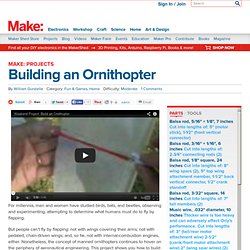

Amateur Scientist: Experimenting with Light and Dark Sensors. This project first appeared in MAKE Volume 38, on pages 94–95.

Robotics, manufacturing, intruder detection, and signaling. These are just a few of the applications for electronic circuits that detect the presence or absence of light. Dark-activated nightlights and street lamps are among the most common applications. So are infrared remote control receivers. A wide variety of semiconductor light sensors is readily available and you can quickly learn to use them by plugging simple circuits into a solderless breadboard. WAVEcopter: A Waterproof Quadcopter. WAVEcopter is a fully waterproof multicopter frame that I have constructed mostly from readily available and cheap electrical parts.

My reasons for building it were to gain a new perspective on surfing photography, do aerial surveying of event sites, and to satisfy my general fascination with robotics and aviation. I rebuilt the copter after it suffered a serious collision into a cliff on the south coast of Cornwall, England. (I believe it was a pilot error after relying too much on a GPS fix and moving the copter from its initial takeoff point.) Although this was a serious collision — full throttle into a granite cliff face at about 60 feet — all of the electronics and camera equipment was unscathed. Repeat After Me: A Mintronics Memory Game. Hot/Cold LEDs. In this project, we will combine an Arduino, a Ping sensor, and a small assortment of components, to build a project that senses distances as "hot/cold.

" Once built, we’ll walk through the software running our basic "sketch," (what an Arduino program is called) and then experiment with variations of the "hot/cold" theme, all the while using the same circuit. For the Arduino sketch files provided, the V1 sketch is detailed below. It measures distance from the sensor. Mini Rover Redux. This project is based on work by MAKE magazine contributor Tom Zimmerman.

Tom, who was honored in 2009 as California’s Volunteer of the Year for his unpaid teaching campaign in public schools, developed the idea as a hands-on activity to accompany his talks about the Mars rover program. Pedal Power Phone Charger. MAKE contributing writer Alastair Bland first introduced us to this simple, effective circuit back in 2009 .
It takes higher-voltage alternating current (AC) from a retro-style bike headlight generator, converts it to direct current (DC), and steps it down to a safe voltage for charging your cell phone or other mobile device. You may have one of these old bike generators lying around. Easy LED Color Organ. Step #2: Connect the audio jack.

Internet Kill Switch. The advent of the always-on internet connection has transformed modern computing.

While you’re away from the keyboard, your software can automatically update itself, fixing bugs and patching security flaws. Or automatically back up data from your hard drive to a remote server so that, in the event of disaster, you still have a record of even your most recent work. Distributed computing applications like SETI@home and Folding@home allow you to contribute your computer’s processing power, while you’re not using it, to solving computation-intensive problems like identifying extraterrestrial transmissions and understanding complex biomolecules.
There’s all kinds of good stuff your computer can do with that internet connection, while you’re away. Mini Blind Minder. Sometimes the sun is my friend, warming the house on cool days.

Other times it’s my enemy, warming the house on hot days. Blinds are one solution to this problem, but it seems that no matter how I set my blinds before I leave for the day, the weather changes and I come home to a sweltering or freezing house. Building an Ornithopter. For millennia, men and women have studied birds, bats, and beetles, observing and experimenting, attempting to determine what humans must do to fly by flapping.

But people can’t fly by flapping: not with wings covering their arms; not with pedaled, chain-driven wings; and, so far, not with internal-combustion engines, either. Nonetheless, the concept of manned ornithopters continues to hover on the periphery of aeronautical engineering. This project shows you how to build a small, rubber band-powered ornithopter we call Orly. There are many types of ornithopter designs. SunBEAM Seeker Bot. BEAM robotics is a way of thinking about and building robots with roots in the “behaviorist” or “actionist” robotics movement of the 1980s. Rather than relying on microprocessors, programming, and digital logic, BEAM designs favor discrete components, stimulus-response control systems, and analog logic.
Make Your Own D*mn Board – Part 1: Layout. There are many tools for creating printed circuit boards, from the open source KiCAD to various online services.

CadSoft’s EAGLE is a favorite in the open hardware community. Here you’ll learn the basics of PCB design in EAGLE, plus how to build the essential core of an ATmega microcontroller board. The Really Bare Bones Board (RBBB) and its schematic were originally designed by Paul Badger of Modern Device. It’s pretty much the bare minimum needed for a useful Arduino-type development board.